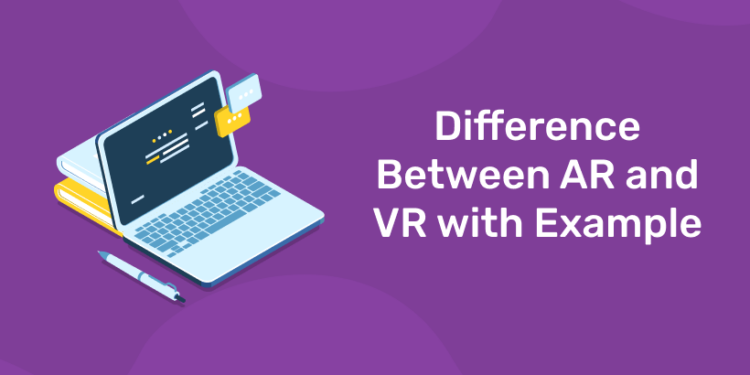Table of Contents
Technology is advancing and modernizing at an accelerated rate. What we used to think of as pure fiction is turning into reality every day. The terms “virtual reality” and “augmented reality” (AR and VR) are frequently used, and both technologies are expanding quickly. Virtual reality and augmented reality are two types of reality technologies that either improve or substitute a simulated environment for the real world.
The future of gaming, marketing, e-commerce, education, and many other industries has great promise for virtual reality (VR) and augmented reality (AR). Both technologies are renowned for their enhanced experiences that merge the actual world with the virtual one using better, 3-D images.
Unravel the fascinating world of Augmented Reality (AR) and Virtual Reality (VR) as we break down their key differences and provide captivating examples to illustrate each technology’s unique capabilities. Understand how AR enriches the real world with digital overlays, while VR immerses you in entirely virtual environments. Get inspired by practical use cases that showcase the power and potential of AR and VR in revolutionizing industries and user experiences. Dive into our comprehensive guide to grasp the contrast between these cutting-edge technologies
Learn to code from industry experts! Get free Demo Classes Here!
Difference Between AR and VR
AR users can control their presence in the real world; VR users are controlled by the system. Virtual reality and augmented reality accomplish two very different things in two very different ways, despite their similar designs. Whereas virtual reality replaces your vision, augmented reality adds to it.
What Is Augmented Reality (AR)?
Augmented reality (AR) is an enhanced version of the real physical world that is achieved through the use of digital visual elements, sound, or other sensory stimuli and delivered via technology. It is a growing trend among companies involved in mobile computing and business applications in particular.
Amid the rise of data collection and analysis, one of augmented reality’s primary goals is to highlight specific features of the physical world, increase understanding of those features, and derive smart and accessible insight that can be applied to real-world applications. Such big data can help inform companies’ decision making and gain insight into consumer spending habits, among others.
crack your career in data science ! join now !
What Is Virtual Reality (VR)?
Virtual Reality (VR) is a simulated experience when the world you’re standing in is replaced with a virtual one. This can be done with something as simple as a plastic holder you put your phone into, but most people prefer head-mounted displays these days. Virtual Reality has revolutionized the gaming and entertainment sectors by allowing users to immerse themselves in a highly simulated environment. Virtual reality is also a big player in the education sector- such as medical or military training- and business- such as virtual meetings.
The VR headset has historically needed to be tethered to a device, but more recent versions can be used as stand-alone or wireless. The most famous VR headset for commercial use is the Oculus Quest 2; the targeted PRO version for business is the Vive Focus 3.
- VR enhances the user experience to the next level via VR headsets or other VR devices like Oculus quest 2, Hp reverb G2, etc.
- VR is a self-controlled environment where the user can control the simulated environment via a system.
- VR enhances a fictional environment by using sensors, displays, and other features like motion tracking, Movement tracking, etc.
Learn to code from industry experts! Get free Demo Classes Here!
Key Differences between AR and VR
From a technological perspective, you’ll see that AR and VR technology are more dissimilar from one another than you initially assumed. Some technical differences between these two innovative technologies are listed belw:
| AR | VR |
|---|---|
| The system augments the real-world scene | Completely immersive virtual environment |
| In AR User always have a sense of presence in the real world | In VR, visual senses are under control of the system |
| AR is 25% virtual and 75% real | VR is 75% virtual and 25% real |
| This technology partially immerses the user into the action | This technology fully immerses the user into the action |
| AR requires upwards of 100 Mbps bandwidth | VR requires at least a 50 Mbps connection |
| No AR headset is needed. | Some VR headset device is needed. |
| With AR, end-users are still in touch with the real world while interacting with virtual objects nearer to them. | By using VR technology, VR user is isolated from the real world and immerses himself in a completely fictional world. |
| It is used to enhance both real and virtual worlds. | It is used to enhance fictional reality for the gaming world. |
How Does AR Technology Work?
AR uses computer vision, mapping as well as depth tracking in order to show appropriate content to the user. This functionality allows cameras to collect, send, and process data to show digital content appropriate to what any user is looking at.
In Augmented reality, the user’s physical environment is enhanced with contextually relevant digital content in real-time. You can experience (AR) augmented reality with a smartphone or with special hardware.
How Does VR Technology Work?
Virtual reality is a technique that simulates vision to create a 3D world in which the user appears to be immersed while surfing or experiencing it. The user experiencing the 3D world then controls it in full 3D. On the one hand, the user creates 3D VR settings, while on the other, he experiences or explores them using suitable equipment such as VR headsets.
Some gadgets, such as controllers, enable users to control and explore the material. VR technology will be used to understand photos and movies based on image position, surroundings, and appearance. This includes using equipment such as cameras and other technologies such as artificial intelligence, big data, and vision.
Are you aspiring for a booming career in IT? If YES, then dive in |
||
Full Stack Developer Course |
Python Programming Course |
Data Science and Machine Learning Course |
Here are some actual examples you can engage with today.
Augmented Reality Examples
- Target app. The Target retail app feature called See it in Your Space enables users to take a photo of a space in their home and digitally view an object, like a picture on the wall or a chair, to see how it will look there.
- Apple Measure app. The Measure app on Apple iOS acts like a tape measure by enabling users to select two or more points in their environment and measure the distance between them.
- Snapchat. Snapchat filters use AR to overlay a filter or mask over the user’s Snap or picture.
- Pokemon Go. Pokemon Go is a popular mobile AR game that uses the player’s GPS to detect where Pokemon creatures appear in the user’s surrounding environment for them to catch.
- Ikea Place is a mobile app that allows you to envision Ikea furniture in your own home, by overlaying a 3D representation of the piece atop a live video stream of your room.
- YouCam Makeup lets users virtually try on real-life cosmetics via a living selfie.
- Ink Hunter: Ink Hunter is one of the most popular free applications available on both the Google Play Store and the Apple App Store. The application allows you to place augmented tattoos on your body through your camera phone, allowing you to take some really cool photos of yourself covered in ink.
- Google Translate: Google Translate makes use of the camera to translate the language in front of the camera into the user’s desired choice of language
Virtual Reality Examples
- YouTube: YouTube has its very own VR application that allows users to watch videos in computer generated virtual environments. The videos provide a 360° view.
- Google Cardboard: This is a must have application for anyone that possesses a Google Cardboard Headset.
- Temple Run 2: If you have a smart phone, then you’re going to want to try out Temple Run 2. It’s one of the top games on both the Google Play Store and the Apple App Store. This game was redesigned to have a virtual environment created for the users, allowing them to be placed on the tracks and run from the monsters chasing them.
- Architects are using VR to design homes — and let clients “walk through” before the foundation has ever been laid.
- Automobiles and other vehicles are increasingly being designed in VR.
- Firefighters, soldiers and other workers in hazardous environments are using VR to train without putting themselves at risk.
Take the first step towards mastering coding – schedule your free demo today!
Advantages of AR and VR
1: Which of the following data structures allows elements to be added and removed in a Last-In, First-Out (LIFO) order?
| AR | VR |
|
|
Explore Free Coding Courses!
Take your first step toward mastering in-demand skills, acing interviews, and securing top-tier jobs with Entri's free coding courses.
👉 Explore Free Courses NowDisadvantages of AR and VR
| AR | VR |
|
|
Don’t miss out on the chance to try our coding course for free – schedule a demo today!
| Our Other Courses | ||
| MEP Course | Quantity Surveying Course | Montessori Teachers Training Course |
| Performance Marketing Course | Practical Accounting Course | Yoga Teachers Training Course |
Explore Free Coding Courses!
Take your first step toward mastering in-demand skills, acing interviews, and securing top-tier jobs with Entri's free coding courses.
👉 Explore Free Courses NowFrequently Asked Questions
What are VR examples?
What is the use of AR examples?
- Photograph filters
- Automotive controls
- Gaming
- Navigation systems
- Healthcare
- Marketing
- Real estate
- Education
What was the first example of VR?
Where is VR commonly used?
Who invented AR and VR?
American computer scientist Ivan Sutherland
How is VR used today?
What is the original name for AR?
ArmaLite Rifle











